Artificial Joint Replacement of the Finger - North Hill Physiotherapy's Guide
|
||||||
Introduction
Physiotherapy in Calgary for Hand Surgery
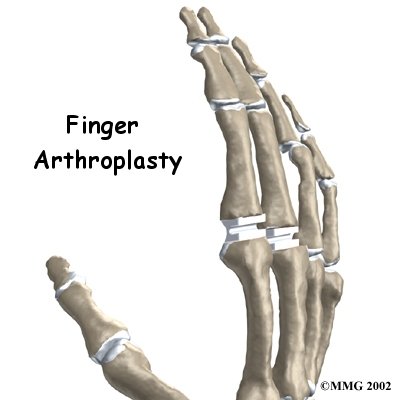
Welcome to North Hill Physiotherapy's resource about artificial joint replacement of the finger.
If nonsurgical treatments are not successful in easing problems of finger arthritis, your doctor may recommend replacing the surfaces of the joint. Joint replacement surgery is called joint arthroplasty.
This guide will help you understand:
- what parts make up the finger joint
- how the operation is performed
- what to expect before and after surgery
- North Hill Physiotherapy’s guide to rehabilitation after surgery
Anatomy
What parts of the finger are involved?
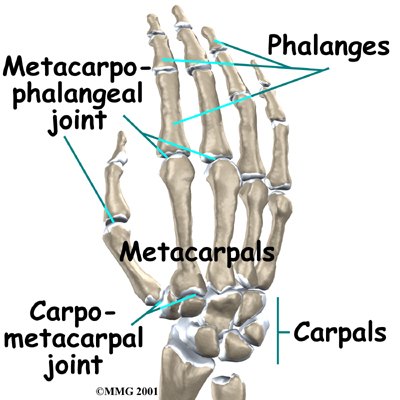
The finger joints work like hinges when they bend and straighten. The main knuckle joint is the metacarpophalangeal joint (MCP joint). It is formed by the connection of the metacarpal bone in the palm of the hand to the finger bone, or phalange. Each finger (the thumb is not termed a finger) has three phalanges, separated by two interphalangeal joints (IP joints). The one closest to the MCP joint (knuckle) is called the proximal IP joint (PIP joint). The joint near the end of the finger is called the distal IP joint (DIP joint).
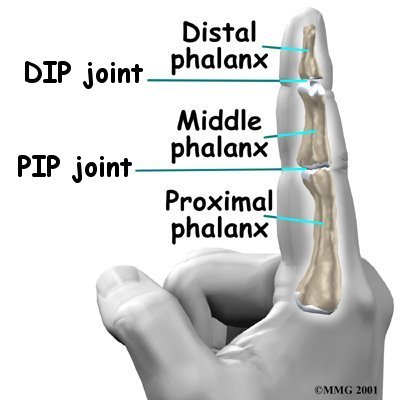
Ligaments are tough bands of tissue that connect bones together. Several ligaments hold the joints together in the finger. These ligaments join to form the joint capsule of the finger joint. The joint capsule is a watertight sac around the joint. The joint surfaces are covered with a material called articular cartilage. This material is the slick, spongy material that allows one side of a joint to slide against the other joint surface easily. When this material wears out, the joint develops a type of arthritis called osteoarthritis and becomes painful. Rheumatic arthritis is a different form of arthritis (which develops due to an autoimmune disorder and is more widespread in the body) but can also cause wearing out of the joint surfaces and also deformity of the joints.
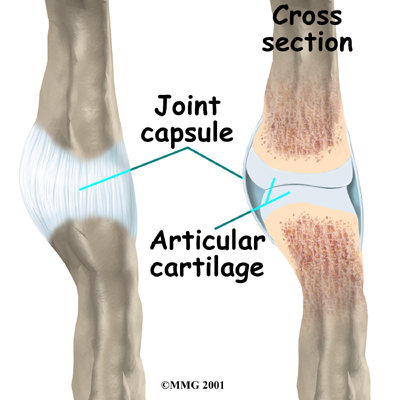
Related Document: North Hill Physiotherapy's Guide to Hand Anatomy
Rationale
Why is an artificial joint replacement done for a finger?
Arthritic joint surfaces can be a source of stiffness, pain, and swelling. Many of these symptoms will respond to physiotherapy at North Hill Physiotherapy but when the symptoms don’t respond or become too much to bear, a joint replacement may be suggested. The artificial joint is used to replace the damaged joint surfaces so patients can do their activities with freedom of movement and less pain.
Preparation
What should I do to prepare for surgery?
The decision to proceed with surgery must be made jointly by you and your surgeon. Your physiotherapist may also liaise with your surgeon to confirm the types of therapy techniques trialed and confirm the ineffectiveness of conservative therapy. You need to understand as much about the joint replacement procedure as possible. Any concerns or questions you have should be brought up to your surgeon.
Once you decide to go ahead with the joint replacement surgery, you need to take several steps. Your surgeon may suggest a complete physical examination by your regular doctor.
This exam helps ensure that you are in the best possible condition to undergo the operation.
A preoperative visit to one of our physiotherapists at North Hill Physiotherapy will also help to prepare you for your surgery. We will start to teach you some of the rehabilitation exercises you will use during your recovery. It is often easier to try these exercises prior to the surgery, when there is no surgical pain and you are feeling well. Your physiotherapist at this time can also help you anticipate any special needs or problems you might have at home, once you are released from the hospital.
On the day of your surgery, you will probably be admitted to the hospital early in the morning. You shouldn't eat or drink anything after midnight the night before. If a general anesthesia is used then the length of time you spend in the hospital depends a lot on your recovery from the anesthesia after surgery. In general, finger joint surgery can be done on an outpatient basis, meaning you can leave the hospital the same day.
Surgical Procedure
What happens during the operation?
The Artificial Finger Joint
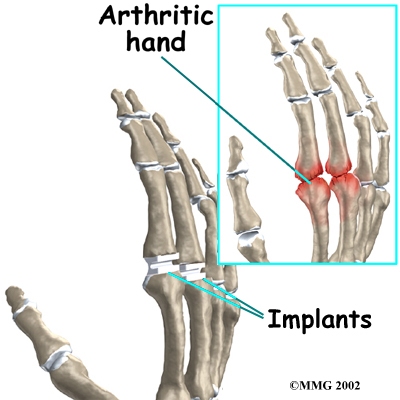
Surgeons use silicon plastic implants to replace the original joint surfaces. The artificial joint functions the same way a hinge on a door does.
The Operation
The procedure takes about two hours to complete. Surgery may be done using a general anesthetic, which puts you completely to sleep, or a local anesthetic, which numbs only the hand. With a local anesthetic you may be awake during the surgery, but you won't be able to see the surgery.
Once you have had the anesthesia, your surgeon will make sure the skin of your hand is free of infection by cleaning the skin with a germ-killing solution.
An incision is made across the back of the finger joints that are to be replaced. The soft tissues are spread apart with a retractor. Special care is taken not to damage the nearby nerve that passes by the joint. The joint is exposed. The ends of the bones that form the finger joint surfaces are taken off, forming flat surfaces.
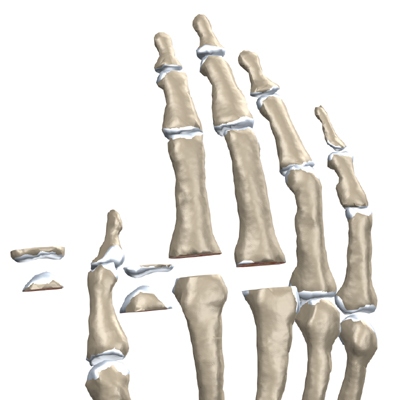
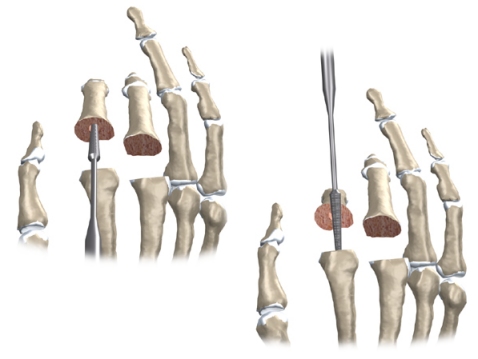
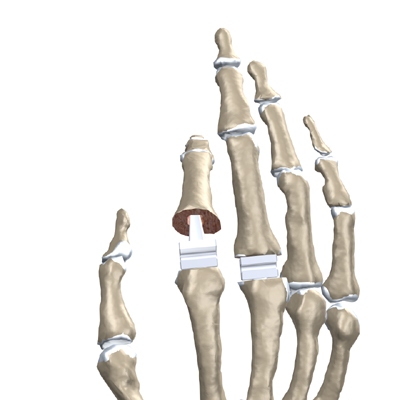
A burr (a small cutting tool) is used to make a canal into the bones that form the finger joint.
The surgeon then sizes the stem of the prosthesis to ensure a snug fit into the hollow bone marrow space of the bone. The prosthesis is inserted into the ends of both finger bones.
When the new joint is in place, the surgeon wraps the joint with a strip of nearby ligament to form a tight sac. This gives the new implant some added protection and stability.
The soft tissues are sewn together, and the finger is splinted and bandaged.
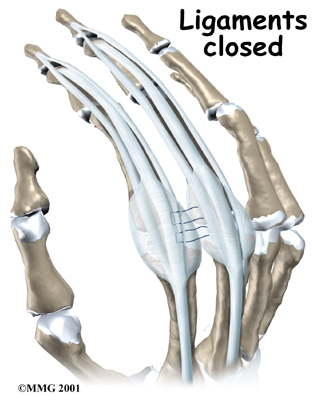
View animation of removing the joint surfaces
View animation of forming the canal in the bones of the finger
View animation of inserting the new finger joint
After Surgery
What happens immediately after surgery?
As mentioned above, after surgery, your finger will be bandaged with a well-padded dressing and a splint for support. The splint will keep the finger in a straightened position during healing. Some patients are placed in an arm-length cast with the finger in a straightened position for about three weeks after the prosthesis is implanted. Some only have the splint extend up to the wrist. Your surgeon will want to check your hand in five to seven days. Stitches may need to be removed after 10 to 14 days, though most of your stitches will be absorbed into your body. You may have some discomfort after surgery. You will be given pain medication to control the discomfort.
You should keep your hand elevated above the level of your heart for several days to avoid swelling and throbbing. Keep it propped up on a stack of pillows when sleeping or sitting up. Ice may also be used at this stage for pain relief.
Rehabilitation
What should I expect during my rehabilitation?
Physiotherapy will begin once your surgeon allows it. The time frame regarding when you can move your finger after surgery will depend on several factors including your surgeon’s opinion, the type of replacement used, and potentially other factors that are specific to your injury or recovery. Many patients will be able to start doing general finger range of motion exercises a few days after surgery whereas others will be asked to wait 2-3 weeks before beginning any motion to allow further healing time. Generally, once therapy begins, you will be fitted with a removable supportive finger splint that can be taken off to do your exercises but should be worn at all other times including at night.
As your rehabilitation progresses your surgeon or physiotherapist will determine when it is no longer necessary to wear this splint. Generally it is removed during daytime activities before it is removed completely at night. It may even be needed for up to 3 months post surgically.
Your first physiotherapy sessions at North Hill Physiotherapy will focus on relieving the pain associated with the surgical process as well as the immobilization. We may use modalities such as heat, ice, or electrical current to assist with decreasing any pain or swelling you have around the surgical site or anywhere along the arm, or into the shoulder or hand. Massage to these areas may also be done in order to improve circulation and assist with the pain. Depending on how extensive the splint was some of the muscles of the neck may also initially be painful and therefore may also benefit from some massage treatment to make movement of your entire surgical side easier.
The next part of our treatment will focus on regaining the range of motion, strength, and dexterity in your finger, wrist, hand, elbow, and even shoulder. Your physiotherapist at North Hill Physiotherapy will prescribe a series of range of motion and strengthening exercises that you will practice in the clinic and also learn to do as part of your home exercise program. These exercises may include the use of rehabilitation equipment such as mini pulleys, putty, elastics or balls for strengthening and gripping resistance. In addition to strengthening your grip we will educate you on ways to grip and support items in order to do your tasks without putting too much stress on your new finger joint.
If necessary, your physiotherapist will mobilize your finger joint or any other joint in the area that is stiff and impeding normal movement of your hand and limb. This hands-on technique encourages the stiff joints to move gradually into their normal range of motion.
Being able to move your hand and finger so that you can complete your work tasks and daily activities is the goal for our therapy at North Hill Physiotherapy. Maximizing dexterity can greatly improve the functional use of your hand. For this reason, we will also incorporate activities like picking up items from a table or twisting items into place using your surgical hand. These functional activities encourage the joints and the muscles of the hand and arm to work in unison, which is critical to maximizing the use of your entire upper limb. Exercises where weight is put through your new joint, such as pressing the pad of your finger into something, will also be added, when appropriate, to encourage the joint to tolerate weight in a controlled fashion.
When you are well underway, regular visits to North Hill Physiotherapy will end. Your therapist will continue to be a resource, but you will be in charge of doing your exercises as part of an ongoing home program. Generally, the majority of your gains from physiotherapy will occur within the first 2-3 months after the joint is replaced, but ongoing tissue remodeling will occur even up to 12 months post-surgery.
In the majority of cases the physiotherapy we provide at North Hill Physiotherapy after finger joint replacement surgery occurs without any complications. If, however, during rehabilitation your pain continues longer than it should or therapy is not progressing as your physiotherapist would expect, we will ask you to follow-up with your surgeon to confirm that the joint replacement is tolerating the rehabilitation well and to ensure that there are no hardware issues that may be impeding your recovery.
North Hill Physiotherapy provides services for physiotherapy in Calgary.
Complications
What might go wrong?
As with all major surgical procedures, complications can occur. Some of the most common complications with an artificial joint replacement of the finger are highlighted below:
- reaction to the anesthesia
- infection
- nerve damage
- prosthesis failure
Anesthesia
Problems can arise when the anesthesia given during surgery causes a reaction with other drugs that the patient is taking. In rare cases, a patient may have problems with the anesthesia itself. In addition, anesthesia can affect lung function because the lungs don't expand as well while a person is under anesthesia. Be sure to discuss these risks and your concerns with your anesthesiologist.
Infection
Any operation carries a small risk of infection. Replacing the finger joint is no different. You will probably be given antibiotics before the operation to reduce the risk of infection. If an infection occurs you will most likely need antibiotics to cure it. You may need additional operations to drain the infection if it involves the area around the hardware. In these cases, the hardware may need to be removed.
Nerve Damage
All of the nerves and blood vessels that go to the finger travel across, or near, the finger joint. Since the operation is performed so close to these important structures, it is possible to injure either the nerves or the blood vessels during surgery. The result may be temporary if the nerve injury has come from the nerve being stretched by retractors during the surgery holding them out of the way. It is uncommon to have permanent injury to either the nerves or the blood vessels during this surgery, but it is possible.
Prosthesis Failure
Unfortunately artificial replacement prosthesis can fail. The older silicon-type prosthesis has been shown to break apart and fragment. Most types of prostheses have the potential to displace, or move out of the correct position, causing problems. Most of these problems will require a second operation to remove and replace the prosthesis.
Portions of this document copyright MMG, LLC.


